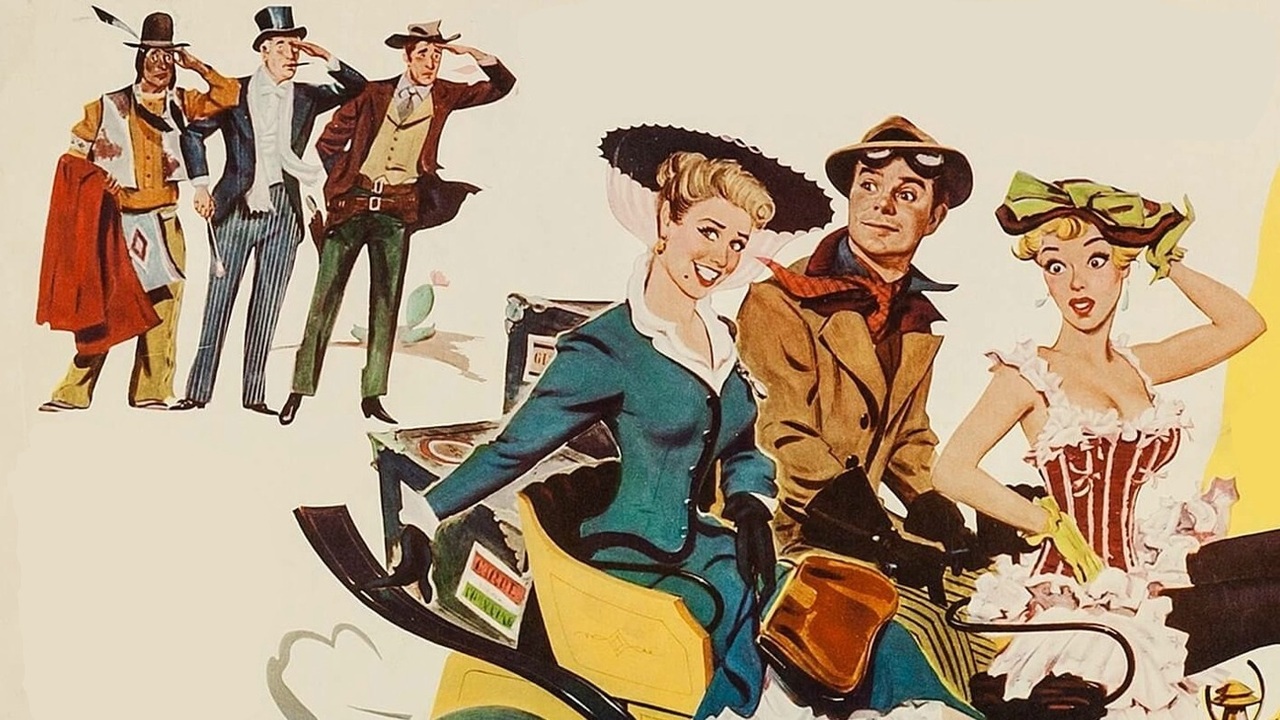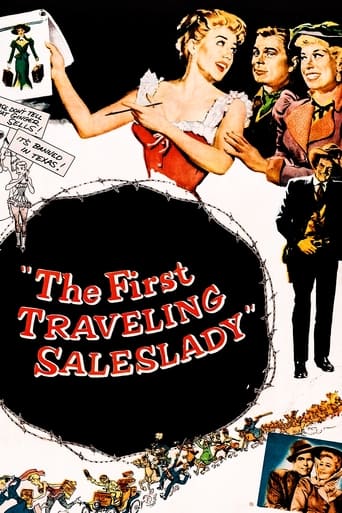

Selling barbed wire on the road proves unexpectedly challenging for a former corset saleslady and her fashion model friend in this breezy western comedy starring Ginger Rogers. While quite clearly intended as a late career vehicle for the Oscar winning actress, it is the supporting players who come off best here. With all her pro-feminist ranting and raving, Rogers is actually a rather grating presence. Fortunately, Carol Channing is simply delightful as her model friend - full of energy and frequently funny, especially when singing the tune "A Corset Can Do a Lot for a Lady" with bizarre vocal changes throughout. James Arness also leaves an indelible impression as a charismatic Texas rancher intent on stopping barbed wire sales, and the film of course features Clint Eastwood's first true supporting (as opposed to 'bit part') role with a solid ten minutes or so of screen time. Barry Nelson as the 'true' inventor of the modern automobile, however, gets on the nerves just as much as Rogers and the repeated coincidental meetings between them come off as poorly scripted rather than spontaneous or funny. The entire film though has trouble in the humour department with groan-inducing lines such as "I can't understand a word he's snoring". Rogers and Channing apparently both detested the film and dubbed it 'Death of a Saleslady'. With a couple of bright songs, some memorable supporting performances and neat animated opening credits, the film is not as bad as all that, but their contempt for the film is also understandable.
... View MoreOne of the final RKO radio films produced in the last leap of faith in 1956. THE FIRST TRAVELING SALESLADY is a very enjoyable light comedy. What sets it apart from TV shows like PETTICOAT JUNCTION or films like OKLAHOMA both of which it strongly resembles is the A studio production values which allow the film to take on a lavish western look more akin to CALAMITY JANE. It is a jalopy western set in the horseless carriage days of 1899. Ginger Rogers was 43 and Carol Channing was 35 in production and given the mature age of both and the feminist slant of the story, it makes for a liberating tone for a film of the mid 50s. It is well worth looking at the last 20 films made at the RKO studio in this period by RKO TELERADIO PRODUCTIONS who revived the label after Howard Hughes trashed it. All 1955-58 RKO films are very well made, above the prior years of Hughes. TRAVELING SALESLADY is beautiful to see and has visuals cluttered with style and color. I thought it quite lavish in some scenes with overstuffed furniture and antiques that must have helped see unloved props get a final airing. In widescreen and technicolor it must have resembled GIGI or THE MERRY WIDOW. The most hilarious scenes to really really lap up involve a very young Clint Eastwood (25 years old) kissing Carol Channing! Fantastic! They elope together in the last reel! The railway station Ginger arrives at earlier at is the same as seen in OKLAHOMA, the last big musical distributed by RKO; Their very last film a minor but snazzy musical was THE GIRL MOST LIKELY also beautifully produced. Shame they gave up, but their films of the time, terrific as they were and modern in tone, just did not include respectable profits to continue. All other studios big and small had at least one blockbuster in this period, but alas RKO and Republic did not and folded.
... View MoreWas that Bob Hope I glimpsed as an Indian whom Ginger Rogers encounters out in front of the hotel when she arrives in the West? I didn't get a good look, but could swear it was him mugging. This is an easy film to relax and enjoy, if you don't expect too much. Carol Channing is a hoot, especially when she is singing. (I think she improved some by the time she did Hello, Dolly.) Clint Eastwood has come a long way since this performance. And I don't think I've ever seen James Arness in anything outside of Gunsmoke. The movie is full of strained jokes and unlikely coincidences, all contrived to make the best of an obviously limp script and a cast of stars. Watch it if you have a couple of hours to kill.
... View MoreThis film is an interesting time capsule. It was made in the late 1950s, and it shows some stars who are on their way up, and one who is on her way out. An unfair thing to say to Ginger Rogers, but this is not one of the films (like KITTY FOYLE, her movies with Fred Astaire, THE MAJOR AND THE MINOR, or ROXY HART) that people remember her for. Ginger would still be making films until 1965, her last one an Italian comedy with Ray Milland, but they were all lesser efforts - although she did deliver good performances. But three (no, make it four) of the stars actually were on their way up - or seemed to be. They are Clint Eastwood, Carol Channing, James Arness, and Barry Nelson. It was the sixth or seventh movie Eastwood had appeared in, and (I believe) the first one where he 1) had substantial dialog to give his film persona a real character, and 2) he was one of the male leads and was paired with the second female lead whom he romances, kisses, and marries. This is Ms Channing, playing "Molly", Rogers closest friend and partner in the saleslady business. Channing's character actually has better lines (at times) than Rogers did - funnier ones too. She is no budding feminist, but a rationalist (when she and Rogers are threatened for selling barbed wire in cattleman country, she suggests - reasonably - that they leave). It might strike a modern film lover as incongruous that Eastwood and Channing go off together at the end of this film, but in reality it's not so odd. Channing was always a greater Broadway star than Hollywood star (her best screen role would be in THOROUGHLY MODERN MILLIE, where she was Mary Tyler Moore's eccentric aunt who trounces Bea Lillie). She did not make more than a dozen or so films in her career. She is not more than five or six years older than Eastwood, and their pairing together is not so unlikely as it seems (the pairing of Nelson and Rogers is more unlikely). She too landed this role because her career (like Eastwood's) was on the rise - she just having won Broadway laurels in GENTLEMEN PREFER BLONDES as "Loralie Lee". Ironically, that performance was not captured by her on film, but Marilyn Monroe performed it. Also ironic is her pairing as Rogers' friend, as one of Channing's later hit performances was as Dolly Gallagher Levi in the original HELLO DOLLY, and she was replaced in it by Rogers.James Arness had been in films since the late 1940s, appearing in several John Ford films like WAGON MASTER, John Wayne films like ISLAND IN THE SKY as well as THEM and some other science fiction movies. But in 1956, the U.S. public was getting used to Arness in the television western hit GUNSMOKE (as Marshall Matt Dillon). That role of a lifetime (literally) made his name and career - he was on the way to super stardom. So his performance as Joel Kingdom, ostensibly the villain of the film, is balanced by his sense of humor and his interest in possibly marrying Rogers.The fourth figure was Barry Nelson. Nelson is an interesting person. He was a capable performer, and he did have one real good comic lead part in MARY, MARY. But while respected in the industry, Nelson never made it with the public. He was good looking but not striking (Arness has a more rugged handsome appearance, which stood him well in GUNSMOKE and other western roles). Upon some reconsideration one can add a fifth figure - David Brian. A good looking man, who always looked like he had just left a hefty Board Room conference with fellow company directors, he gave some excellent performances in his career as good guy (he ends up with Joan Crawford in FLAMINGO ROAD) or bad guy. But like Nelson, while he was always employable he never caught on with the public. Here, he too is interested in Rogers. He reluctantly agrees to her selling the barbed wire in Texas, but he does so because when she fails he plans to marry her. All this does in the end is lead to him and Arness having a fistfight, but both discovering that Nelson has outmaneuvered them with another sigh of progress - Nelson's horseless carriage.It is a sweet little film, but no more than that. My favorite moment comes in the hotel sequences. Rogers and Channing trick Arness into giving up his use of the PRINCE OF WALES suite in a cattle town hotel. They are looking forward, after dinner, to sleeping in this fancy room. They find a bald, bearded fat man snoring in the bed. It turns out it is Prince Albert Edward (the future King Edward VII) who has come to town after all, and has a running right to the use of the room.
... View More